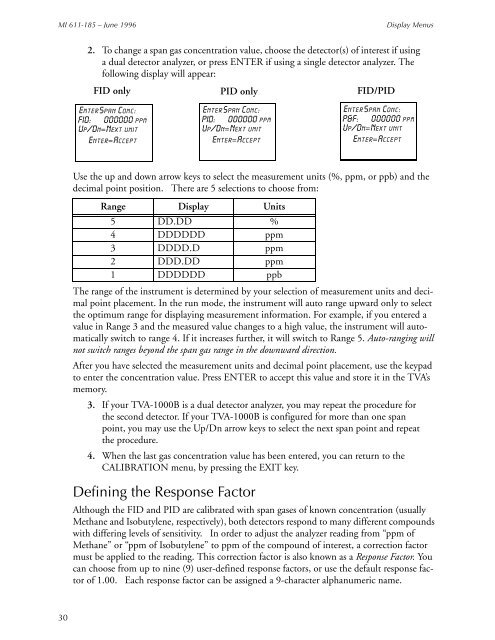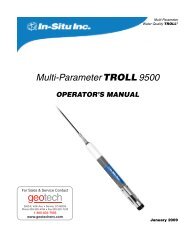Thermo Scientific TVA-1000B Instruction Manual - Geotech ...
Thermo Scientific TVA-1000B Instruction Manual - Geotech ...
Thermo Scientific TVA-1000B Instruction Manual - Geotech ...
Create successful ePaper yourself
Turn your PDF publications into a flip-book with our unique Google optimized e-Paper software.
MI 611-185 – June 1996<br />
Display Menus<br />
2. To change a span gas concentration value, choose the detector(s) of interest if using<br />
a dual detector analyzer, or press ENTER if using a single detector analyzer. The<br />
following display will appear:<br />
FID only PID only FID/PID<br />
Enter Span Conc:<br />
FID: 000000 ppm<br />
Up/Dn=Next unit<br />
Enter=Accept<br />
Enter Span Conc:<br />
PID: 000000 ppm<br />
Up/Dn=Next unit<br />
Enter=Accept<br />
Enter Span Conc:<br />
P&F: 000000 ppm<br />
Up/Dn=Next unit<br />
Enter=Accept<br />
Use the up and down arrow keys to select the measurement units (%, ppm, or ppb) and the<br />
decimal point position. There are 5 selections to choose from:<br />
Range Display Units<br />
5 DD.DD %<br />
4 DDDDDD ppm<br />
3 DDDD.D ppm<br />
2 DDD.DD ppm<br />
1 DDDDDD ppb<br />
The range of the instrument is determined by your selection of measurement units and decimal<br />
point placement. In the run mode, the instrument will auto range upward only to select<br />
the optimum range for displaying measurement information. For example, if you entered a<br />
value in Range 3 and the measured value changes to a high value, the instrument will automatically<br />
switch to range 4. If it increases further, it will switch to Range 5. Auto-ranging will<br />
not switch ranges beyond the span gas range in the downward direction.<br />
After you have selected the measurement units and decimal point placement, use the keypad<br />
to enter the concentration value. Press ENTER to accept this value and store it in the <strong>TVA</strong>’s<br />
memory.<br />
3. If your <strong>TVA</strong>-<strong>1000B</strong> is a dual detector analyzer, you may repeat the procedure for<br />
the second detector. If your <strong>TVA</strong>-<strong>1000B</strong> is configured for more than one span<br />
point, you may use the Up/Dn arrow keys to select the next span point and repeat<br />
the procedure.<br />
4. When the last gas concentration value has been entered, you can return to the<br />
CALIBRATION menu, by pressing the EXIT key.<br />
Defining the Response Factor<br />
Although the FID and PID are calibrated with span gases of known concentration (usually<br />
Methane and Isobutylene, respectively), both detectors respond to many different compounds<br />
with differing levels of sensitivity. In order to adjust the analyzer reading from “ppm of<br />
Methane” or “ppm of Isobutylene” to ppm of the compound of interest, a correction factor<br />
must be applied to the reading. This correction factor is also known as a Response Factor. You<br />
can choose from up to nine (9) user-defined response factors, or use the default response factor<br />
of 1.00. Each response factor can be assigned a 9-character alphanumeric name.<br />
30

















